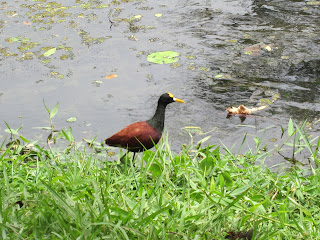 |
| Tree of life |
Our tour guide Diego (seriously) first showed us a gigantic
tree that was known to the Aztecs as the tree of life. They would frequently
bury people at its roots to offer it nutrients, and if the person was
especially important they would be buried inside a hole cut into the tree.
 |
| This one is popular in offices |
The rest of the tour was mostly just a gigantic photo op,
and Diego pointed out many different types of plants (which are frequently
cultivated and exported for decoration) and
animals (mostly iguanas, birds, and one bored horse) that live in the park.
Costa Rica has 5% of the globe's biodiversity, which sounds small but is really not
 |
| Well there aren't alligators in Costa Rica, just crocodiles |
 |
| Male iguanas turn orange like the one on the right to attract females |
 |
| Me and the elephant ear plant, which has the second largest leaves in the world. The plant with the largest also grows in Costa Rica, but not in INBioparque. |

One of the many birds that Diego told us about was the Costa Rican national bird, the Clay-colored Thrush, which is a very plain brown bird that has beautiful, complicated songs. It's sort of like the Susan Boyle of birds. The songs are so varied that in ancient times, crop planting and harvesting would be marked by the seasonal changes in the bird's songs. The legend behind its appearance goes that this bird used to have exquisite feathers, but couldn't sing. He was so jealous of all the other songbirds that he asked Quetzalcoatl (indigenous deity) to be able to sing. His wish was granted and he became the best singer of all the birds, but the price was his beauty. So to Costa Ricans he represents the value of hard work.
Later we visited the butterfly sanctuary, where chrysalises
are bred, researched, and exported for weddings and biological research outside
Costa Rica. The butterflies that are present in people's backyards are the sort
of things that appear extremely exotic anywhere else, and they're a big part of
the ecosystem here. My boyfriend's host dad here has many bushes of a
particular plant (milkweed, maybe) for the sole purpose of being food to enable
caterpillars to grow into butterflies. Walking among them you can see many
empty chrysalises, a few caterpillars scooting around, and several bushes that
have been consumed down to the stems by previous residents. I'm sure some of
you read the children's book "Hungry Hungry Caterpillar;" they may
not eat pears or watermelons, but they are definitely hungry hungry...
 |
| Monarchs here don't migrate like those in North America do. They already have everything they need here, so that instinct does not drive them to leave. |

 One of the last things we accomplished on our tour was
finding a three-toed sloth, which was much
more difficult than you might think since from the ground they look like little
fur balls sitting like growths up at the treetops. Sloths are very strange
animals... They eat flowers and fruits from the trees, and sleep for about 18
hours a day (they nap throughout the other 6). Every 7ish days they climb down to the ground to defecate, allowing a really interesting
example of symbiosis to occur. There are many bugs and beetles that live in its fur. When it comes down
to the ground to poop, many of the beetles hop off of the sloth, lay eggs in
the feces, then catch up with the sloth later. Beyond that, there is also a photosynthetic algae that lives in its fur, which gives it its greenish color and lets it blend in with the trees. It's important for it to hide from predators because
besides hiding, it's a pretty vulnerable animal. It is extremely light (you
could hold an adult with one finger) and its bones are hollow to allow it to
perch on thin branches. But, this also makes it easy for jaguars and harpy
eagles to carry it off, so hiding is the best option.
One of the last things we accomplished on our tour was
finding a three-toed sloth, which was much
more difficult than you might think since from the ground they look like little
fur balls sitting like growths up at the treetops. Sloths are very strange
animals... They eat flowers and fruits from the trees, and sleep for about 18
hours a day (they nap throughout the other 6). Every 7ish days they climb down to the ground to defecate, allowing a really interesting
example of symbiosis to occur. There are many bugs and beetles that live in its fur. When it comes down
to the ground to poop, many of the beetles hop off of the sloth, lay eggs in
the feces, then catch up with the sloth later. Beyond that, there is also a photosynthetic algae that lives in its fur, which gives it its greenish color and lets it blend in with the trees. It's important for it to hide from predators because
besides hiding, it's a pretty vulnerable animal. It is extremely light (you
could hold an adult with one finger) and its bones are hollow to allow it to
perch on thin branches. But, this also makes it easy for jaguars and harpy
eagles to carry it off, so hiding is the best option.



No comments:
Post a Comment